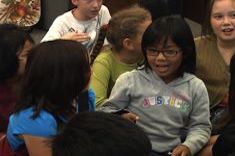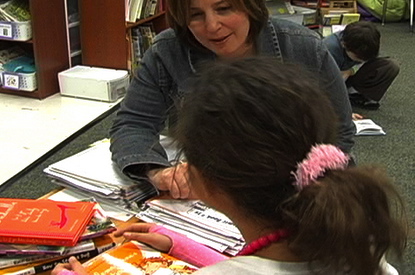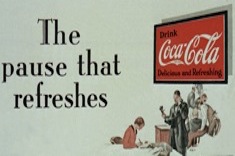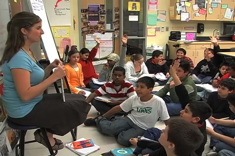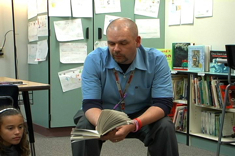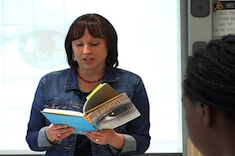About 10 years ago, I began the ritual of having a whole-class conversation each time we finish a chapter book read aloud. I created this idea when I noticed that each time I finished reading the last sentence in the book, my fourth graders immediately asked, “What are we reading next?” They didn’t reflect on the whole text, share burning questions about the characters, discuss lessons they learned, think about how the characters changed, or linger with the book in any way.
I wanted my students to learn how readers take a moment to pause and think about the whole text and talk about it when they finish that last sentence, instead of just closing the book and moving on. I believe conversations are at the heart of reading and that it is important for us to not only make time for our students to have conversations about books, but also to teach them how to have real conversations about their reading. Many times, students have only what I call “popcorn” conversations where they share some isolated thinking by raising their hands. I wanted to change all of that, so I created our classroom ritual of having a whole-class conversation at the end of each chapter book. Students love it!
When we finish our chapter book read aloud, students take time to reflect in their reader’s notebook about the whole text. They write what we call a “last impression” in paragraph form, a bulleted list, or in a chart. In this “last impression,” students think about the impression the characters and the text left on them as a reader and as a person. This may include lessons learned, symbolism, character change, character relationships, character effect, or any other thinking. I always like to write the first “last impression” as a whole class so students have guided practice in writing one. Below is a photo of a “last impression” that our class wrote this year after reading Drums, Girls, and Dangerous Pie by Jordan Sonnenblick.

After writing one as a class, students go off to write one independently to have additional practice. Below is an example of a student’s last impression:
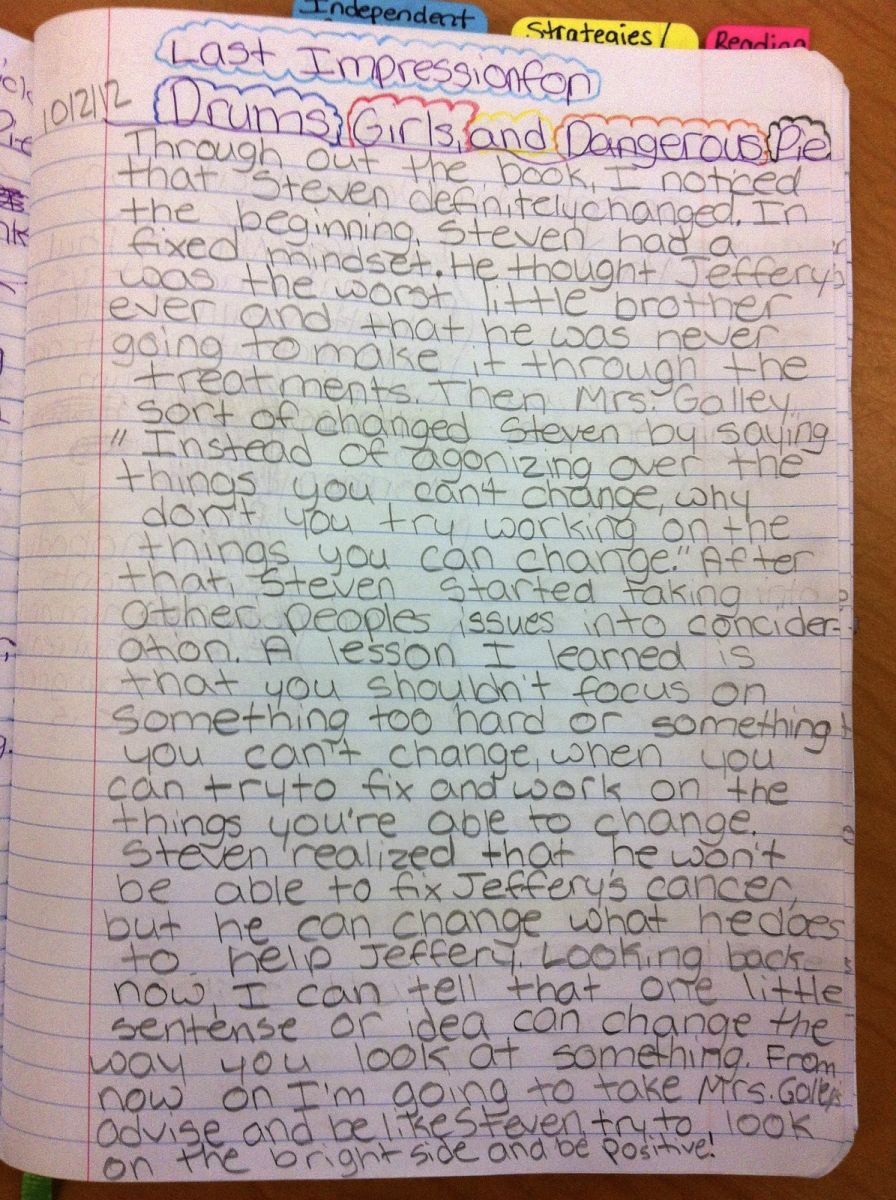
The next day, after students write their last impression, they gather together in a large circle on the rug with their reader’s notebook opened up to their ideas. I love the expression on the students’ faces each year when I tell them that they are not allowed to raise hands in these conversations. Some teachers give me the same expression the first time they hear it too, but they quickly see that students can do it with success if they have enough modeling and coaching.
I always use the example of recess with kids and ask them if they raise their hands when they talk outside on the playground with their friends. They immediately say, “No way!” or an emphatic “No!” This always leads to a great conversation about why people, kids included, don’t raise their hands when they have conversations. We talk about being respectful, having one speaker at a time, and piggybacking onto one another’s ideas. This discussion helps them participate successfully in not only whole-class conversations, but all classroom conversations, because it teaches students essential conversation skills. For example, they learn to politely let someone else speak first if they hear another voice trying to contribute at the same time they are trying to speak. They also learn how to genuinely listen to their classmates’ contributions so they can build upon their ideas or agree/disagree with their ideas. In addition, they learn how conversations can deepen and even change their own thinking! I teach my students to use conversation stems to piggyback on ideas such as these:
-
I agree with _____’s idea that . . . because . . .
-
I disagree with _____’s idea that . . . because . . .
-
I also think . . .
-
In addition to . . .
-
On one hand I agree with . . . , but on the other hand . . .
-
_____’s comment just made me realize . . .
-
This is giving me the idea that . . .
-
Adding on to _____’s idea, I think . . .
-
To go back to _____’s idea, I agree because . . .
My fifth-grade students always benefit from being taught these conversation skills, having them modeled repeatedly, and practicing them on an ongoing basis.
My role during the whole-class conversation is as a facilitator, not a participant, because I want this to be a time for the students’ voices to be heard. As the facilitator, I sit in the circle with my keyboard to create a transcript of the conversation on Google Drive that students can see on the Smartboard. This helps students see their classmates’ thinking, honors their own contribution to the conversation, and keeps a record of it on a Google Doc that students can continue to add to when the conversation is over. As a former elementary school introvert, I know that some of us do not feel comfortable sharing our thinking verbally in front of our peers, so continuing the conversation on Google Drive provides students with the opportunity to share their thinking. I also know that some of our students may struggle to keep up with oral conversations because of the fast processing speed necessary to contribute thinking and build onto their classmates’ ideas. Continuing the conversation digitally gives all students time to process at their own speed.
To launch the conversation, students turn and talk with their reading partner about the topic they think we should focus the conversation on. Students share possible topics as I type their suggestions in a bulleted list. Students turn and talk again to discuss how the topics overlap and how they might be combined. Once a focus is chosen, one student begins the conversation and students take turns sharing their thinking and building on one another’s ideas without raising hands. Students use “thinking stems” to build on one another’s ideas and deepen their level of interpretation as well.
By the time we have our first whole-class conversation, students are well versed in using “thinking stems” as readers and writers. I model using them during read aloud, in minilessons, and in writing examples, and prompt them to use them during partner conversations. Thinking stems help students deepen their thinking, push their thinking in different directions, and build upon ideas. Below are some thinking stems, created by students, that are displayed in our classroom. This visual is a helpful tool that students use frequently to help them deepen their thinking as readers and writers.
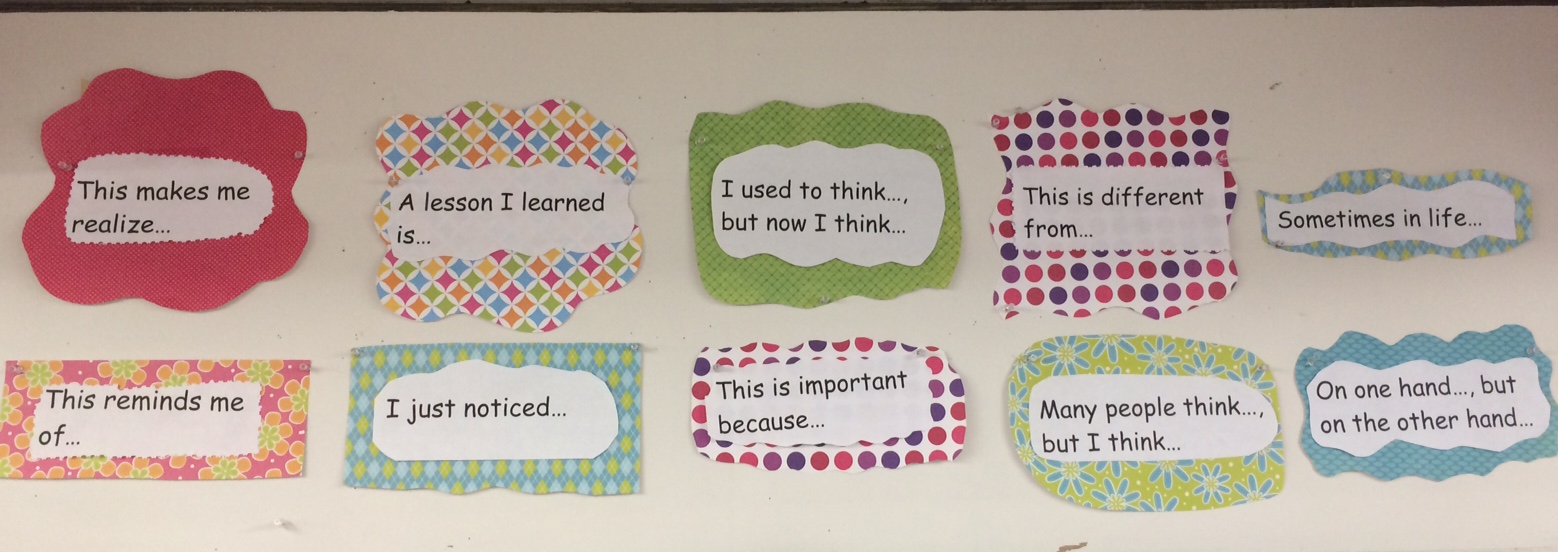
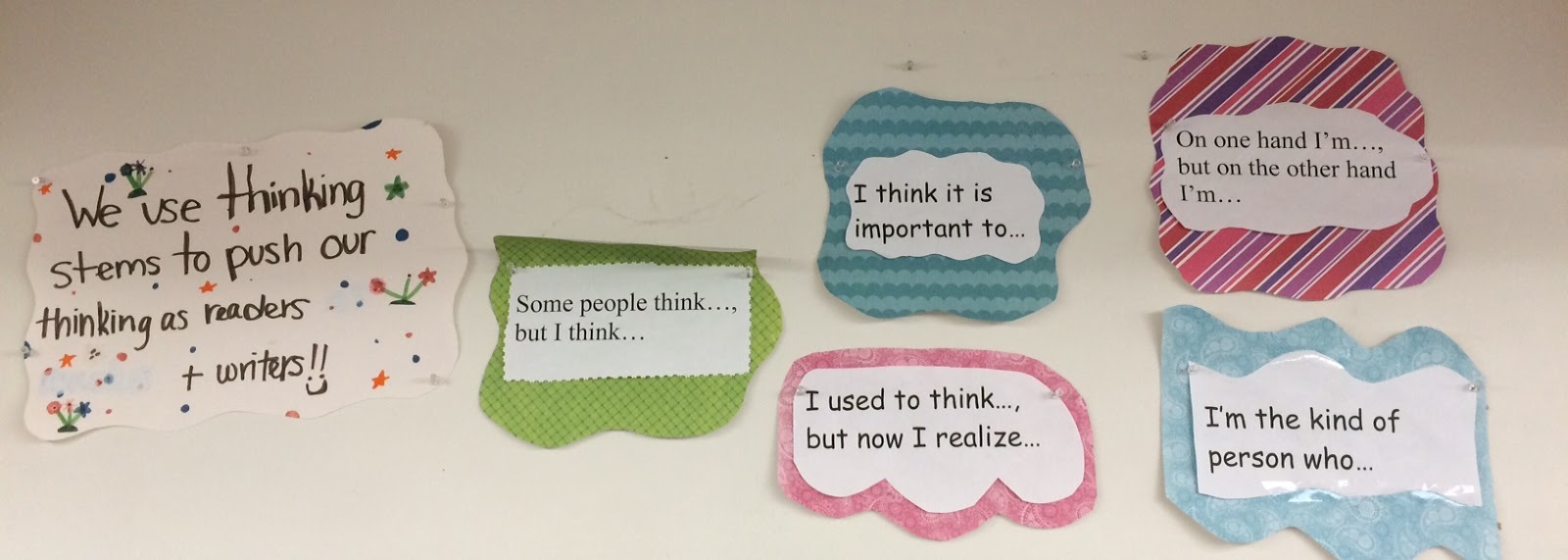
As students share ideas, I transcribe them in Google Docs along with their name next to their idea. This helps students see their classmates’ thinking so they can build upon it as well as see their own name, which they love. If, as the facilitator, I notice that ideas are being repeated, I pause the conversation to recap the overarching ideas talked about so far and pose a question for students to turn and talk about. For example, “So far we have talked about . . . Now I want you to think about . . .” This helps refresh students’ thinking, push their thinking in a different direction, and foster a deeper level of interpretation. Below are examples of how I have paused conversations to help lift the level of thinking within them.
The length of each whole-class conversation is about 20 minutes, but students always have the opportunity to extend the conversation by adding their thinking to the Google Doc at any time.
Whole-class conversations help strengthen partnership and book club conversations, foster critical thinking, and provide opportunities for students to be reflective learners. They also create an environment where students feel comfortable taking risks as learners and sharing their ideas about books! I know we may feel overwhelmed by time constraints in our classrooms and feel there is never enough time in the day for everything we want to teach, but these conversations are well worth every minute they take in our classroom.

